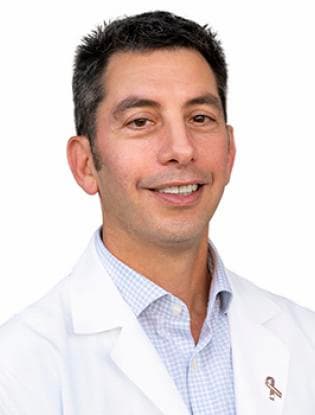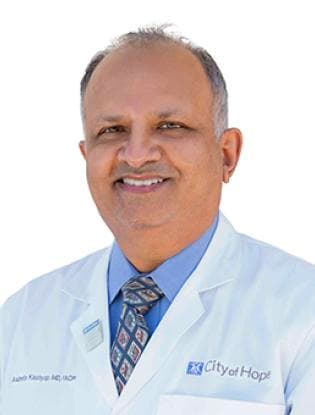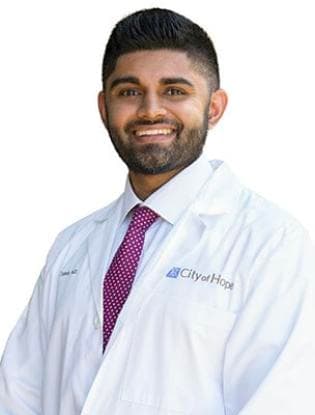CAR T-Cell Therapy Vs Bispecific Antibodies As Multiple Myeloma Treatment
Experts in the field of multiple myeloma gathered to discusses treatment options including bispecific antibodies CAR T-cell therapy, and the importance of collaborative decision-making across clinics.
Michael Rosenzweig, MD, MS
Chief, Division of Multiple Myeloma
City of Hope, Duarte, CA

Ashwin Kashyap, MD
Assistant Clinical Professor
City of Hope, Thousand Oaks, CA

Neel Sagar Talwar, MD
Assistant Clinical Professor
City of Hope, Upland, CA

Natasha Garg, DO, MS
Assistant Clinical Professor
City of Hope, Upland, CA

CancerNetwork® recently hosted a panel discussion on multiple myeloma as a part of a Satellite Sessions program focused on City of Hope. The program brought together experts from the City of Hope’s main center in Duarte, as well as from Upland and Thousand Oaks, in order to discuss the benefits and consequences of using bispecific antibodies and chimeric antigen receptor (CAR) T-cell therapy for patients with multiple myeloma. The panel also discussed the importance of working together with satellite clinics to provide the best possible care for patients.
The panel was led by Michael Rosenzweig, MD, MS, chief of the Multiple Myeloma Division and an associate professor of Medicine at City of Hope, Duarte. Panelists included Ashwin Kashyap, MD, assistant clinical professor in the Department of Medical Oncology and Therapeutics Research at City of Hope, Thousand Oaks; Neel Sagar Talwar, MD, and Natasha Garg, DO, MS, both assistant clinical professors in the Department of Medical Oncology and Therapeutics Research at City of Hope, Upland.
Rosenzweig: In your practice, how do you choose a regimen for relapsed disease and what goes into the decision-making?
Garg: There’s an influx of options that we can choose from, but there’s a few things that I base my decision on. I first see what the patients received in the past. What did they progress on? Is itan early relapse or a late relapse? The other thing I look for is if they can tolerate certain drugs. Certain patients may have cardiac toxicity, so that may limit my options. For patients who have been on standard lenalidomide [Revlimid], bortezomib [Velcade], and dexamethasone [RVd], I may look at the second generation, maybe elotuzumab [Empliciti], pomalidomide [Pomalyst], and dexamethasone for those patients. If a patient has not had daratumumab [Darzalex], then I may introduce daratumumab in this setting. If somebody has had daratumumab, then maybe carfilzomib [Kyprolis] and pomalidomide.
Rosenzweig: It had become very simple for a little while when patients progressed after triplet therapy with RVd to introduce daratumumab right at that time of relapse. Now that we’re using daratumumab up front, it’s becoming more complicated. What are some regimen options in the relapsed setting?
Talwar: I look at the length of time patients were on previous therapy. They might be sensitive to a second-generation proteasome inhibitor if they had a great response with the first generation [proteasome inhibitor] for a prolonged period of time. That’s something to look at with pomalidomide as well. There are obviously other options. Selinexor [Xpovio] is an option for patients who are refractory, as well as elranatamab-bcmm [Elrexfio] in combination with a proteasome inhibitor like lenalidomide.
Rosenzweig: Are there any agents that are not available at the community sites?
Talwar: All the agents would be available at the community sites. The only thing we’re referring to in the refractory setting is chimeric antigen receptor [CAR] T cells and now the bispecific [antibodies]. They do require some collaboration with the main campus, but those may be able to be used in the community at some point.
Kashyap: Because of the bispecific [antibodies] up front potential for toxicity in patients who are frail, we prefer to have the treatment started in Duarte [City of Hope main campus] rather than trying to start in the community [setting]. Clinics are open Monday through Friday, not on the weekends. If there’s a complication on Friday night, that can be very challenging for the patient. We strongly prefer to have the patient start the bispecific treatment [at the main campus], if possible.
Rosenzweig: Let’s take a look at the use of bispecifics and novel cellular therapies. For example, a patient was given teclistamab-cqyv [Tecvayli] and then was subsequently admitted for cytokine release syndrome [CRS] and immune effector cell-associated neurotoxicity syndrome (ICANS) symptoms. The FDA guidelines suggest that the patient is hospitalized for that ramp-up dosing.1 When we decide to start a patient on these agents, we will bring them to the main campus and keep them in the hospital for that ramp-up dosing for this reason. The risk of toxicities needs to be handled at a specialized center, including the CRS and neurotoxicity that can occur early in the treatment courses and tend not to occur so late in the course. There may be an opportunity there to start a patient on the bispecific [antibodies] and then transition out to the satellite clinics in the future once we’re through that high-risk phase.
[Transitioning] to those next-generation proteasome inhibitors makes sense. Being mindful of cardiac toxicity, perhaps it would be best to use the bispecific carfilzomib which has found a new home in the setting of quadruplet induction as a go-to agent in the early relapse setting. A patient who has chosen not to go through transplant may not have seen alkylator treatments because melphalan [Evomela] is such a core of our transplant regimen. Those are some effective agents in multiple myeloma. We may want to avoid those alkylator agents as we get closer to cellular therapies, so we don’t inhibit that T-cell milieu that we depend on for the CAR T-cell treatment. We’re lucky to currently have 2 CAR T cells that are FDA-approved after at least 4 lines of treatment and 1 bispecific talquetamab-tgvs [Talvey].2 Which direction would you go when it comes to choosing a bispecific or a CAR T cell?
Garg: Our experience in the community is limited. For the most part, we let you decide which one is best for our patients in terms of adverse effects (AE).
Rosenzweig: We base it on AE profile, availability, and nature of the disease. The nice thing about bispecifics is that they’re off the shelf and readily available, so we can go to them quickly. The benefit of the CAR T-cell treatments is that it’s more of a “one-and-done” type treatment, which is appealing for most patients. It is a difficult choice, though, and everything has to be done thoughtfully. That’s a great area of collaboration between the satellite sites and the main campus as to how to navigate that decision.
Garg: If it wasn’t for accessibility, is there one that you favor between CAR T or bispecific antibodies?
Rosenzweig: I love the idea of a “one-and-done” treatment for patients who can receive it. We have to be careful as myeloma doctors not to underestimate the impact of weekly treatments or patients continuously being on treatment. With weekly treatments, we may be able to spread that out to every 2 weeks, but it’s taxing and a burden as opposed to the “one-and-done” options that are available with some of the CAR T cells, so I would like to go that direction eventually.
Garg: Are you using the bispecifics to bridge these patients to CAR T?
Rosenzweig: In rare situations, we have used bispecific antibodies to bridge the CAR T cells, and it’s not well known. One of the concerns is that you may lead to T-cell exhaustion if you keep people on bispecifics for a long period of time. For a short course, bispecifics may be an option as a bridge to CAR T cells. We try to avoid that, but there are situations when other options don’t make sense, and we have to use that. What we do is try to avoid those alkylators as much as possible in the bridging situation, whether that’s bridging to leukapheresis or bridging to infusion. Has access to CAR T cells had any impact on your facility?
Kashyap: If the patient is eligible, given that they often have very advanced disease, most of them are at the point where they’re willing to do almost whatever it takes to get CAR T-cell therapy. Although City of Hope [Duarte] is the main campus, and it is a drive, it’s still only a drive. They’re willing to make the drive to get seen. If they’re older and tired of being treated, then that’s the point at which they sometimes say, “I don’t want to pursue anything further.” They tend to declare themselves as to how aggressively they want to continue with treatment. They typically choose between palliative care vs CAR T-cell therapy. Bispecifics are separate. They would still take bispecific therapy. When they get to that point where they’ve had 4 regimens or so, and I refer them [to the main campus], they go with that view in mind to see what they want to do. Many patients are excited about CAR T-cell therapy, not let down. They’re excited about it because they view it as a potential form of immunotherapy and curative [treatment]. They’re looking for that, although there’s no evidence of that.
Rosenzweig: In terms of support in the satellite clinics, such as having access over the weekend, it makes that a challenge. Are there any challenges at City of Hope Upland in using the bispecifics for future dosing?
Talwar: It’s something that would be great for our patients to be able to get in the community. We’re talking about access, and, in every 2-week dosing [schedule], it’ll save them a trip to a much further site than if they can get it in our clinic. It’s something that we can make happen with the right supportive measures in place. We do have the capability of doing it. It’s just a matter of making patients aware of the infectious risk, making sure they’re on the right prophylaxis [treatment] and compliant with it, and making sure that they have access to the emergency department (ED) and that they give us a call if they need to go in.
Rosenzweig: There’s a real opportunity, but there is a risk of patients getting infections. When it’s going well, it’s a tremendous convenience for the patients. When it’s not going well, we need to collaborate as a main campus with the satellite clinics. There’s a real opportunity there for us to collaborate and allow these patients to continue this treatment closer to home and decrease the burden with the right investment in resources and supportive measures.
Garg: Is there any data for sequencing of the bispecifics?
Rosenzweig: There’s no data for sequencing. There was a phase 1b RedirecTT-1 trial [NCT04586426] that was presented at American Society of Clinical Oncology [ASCO] by Yael C. Cohen, MD, which used a combination of 2 bispecifics to multitarget myeloma cells.3 A total of 63 patients were treated with teclistamab and talquetamab after a median of 5 lines [of previous therapy]. About a third of these patients had high-risk cytogenetics. Their overall response rate was 84%. What’s exciting about this trial is that 73% of those responses were in patients with extramedullary disease, which is near the end of the myeloma disease course. If we can get a response for those patients who have advanced myeloma with a 2-pronged approach of targeting both the B-cell maturation antigen (BCMA) and another target, such as GPRC5D, it could be a very exciting time for patients with high-risk disease, particularly those with extramedullary disease. The response rates were even higher when at the recommended phase 2 dosing, which showed that more good things are to come for patients with multiple myeloma as well as more options to consider for myeloma doctors. We have to be mindful of other toxicities that can occur with these medications, not just the risk of infection but also cytopenias. I’m sure in your centers, you are well-versed in managing those issues with supportive measures.
Garg: We frequently monitor patients who are at risk for developing cytopenias. Especially for those patients who have been on systemic therapy for a long amount of time, they’re more at risk for developing these cytopenias. In addition to frequent monitoring, we’re able to provide them with growth factor support and/or transfusions if needed.
Rosenzweig: Are there any specific mechanisms that are in place in the satellite sites that allow for easier monitoring, such as the medical records and nursing support?
Garg: At Upland, we have nurse practitioners who help us do frequent monitoring as well as our head nurses. Many people are helping to monitor these patients, so it’s not all relying just on [clinicians]. We’re going through checks and balances to make sure that we’re not missing any of these cytopenias.
Talwar: The electronic health record [EHR] helps as well. We can monitor our labs through the EHR interface. Records come directly to us, and we get an alert if there’s any critical values, so we can address the [results] right away. Patients can send us messages if there’s any issues through our patient portal, and that can help with some of this monitoring as well.
Rosenzweig: Is that the same at the Thousand Oaks location?
Kashyap: Yes, it’s the same. We have the same system. We are a smaller site than Upland, so we have less staff than Upland, but we still manage to do the same.
Rosenzweig: That’s an exciting part of where we work today. The main campus of City Hope Duarte and all the satellite clinics around Los Angeles County and Orange County and beyond are all using the same EHR, which allows us to collaborate very nicely, communicate with each other, see the labs, and communicate with nurses in an almost seamless way in real-time when patients are in the clinic.
Kashyap: The shared computer system between all our sites means that you can look at a chart just as quickly as I can look at the chart. When we have shared care, that makes a big difference.
Rosenzweig: We’re pleased with our infrastructure and especially our EHR to work together and collaborate nicely.
References
- Talquetamab. Prescribing information. Janssen; 2023. Accessed November 13, 2023. https://shorturl.at/cgjW6
- FDA grants accelerated approval to talquetamab-tgvs for relapsed or refractory multiple myeloma. U.S. Food and Drug Administration. August 9, 2023. Accessed November 13, 2023. https://shorturl.at/qvJS1
- Cohen YC, Morillo D, Gatt ME, et al. First results from the RedirecTT-1 study with teclistamab (tec) + talquetamab (tal) simultaneously targeting BCMA and GPRC5D in patients (pts) with relapsed/refractory multiple myeloma (RRMM). J Clin Oncol. 2023;41(16_suppl):8002-8002. doi:10.1200/jco.2023.41.16_suppl.8002
Newsletter
Stay up to date on recent advances in the multidisciplinary approach to cancer.